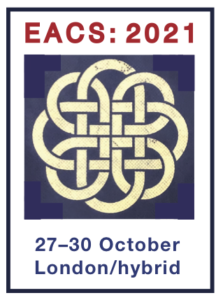Lenacapavir: drug resistance after viral rebound in treatment experienced participants
30 November 2021. Related: Conference reports, Antiretrovirals, Drug resistance, EACS 18 London 2021.
 Simon Collins, HIV i-Base
Simon Collins, HIV i-Base
An oral presentation at EACS 2021 included an analysis of drug resistance from the 26-week CAPELLA study of the capsid inhibitor lenacapavir in people with extensive drug resistance to other classes.
In vitro, key mutations to lenacapavir occur at L68I, M66I, Q67H, K70N, N74S/D and T107M in the binding site, all with reduced fitness (other than Q67H) and none of which are found in people naive to this capsid inhibitor, including at baseline in this study. Mean susceptibility at baseline was 1.0 (0.3 to 1.7).
This study reported results from Cohort 1 in the important CAPELLA study where 36 participants were randomised to 14-day monotherapy or placebo, followed by optimised background regimen (OBR).
Overall, approximately half the participants had four-class resistance and half had resistance to three classes at baseline, limiting active drugs in the OBR.
By week 26, 11/36 participants qualified for resistance testing, with 4/11 (11%) showing capsid resistance. All four had M66I, with single or dual additional mutations from the in vitro list above in 3/4. Follow-up out to week 40 was presented for each of these four cases, which are worth reporting in detail.
Case 1 included suboptimal adherence to OBR suggesting an extended period of lenacapavir monotherapy. Viral rebound at week 28 with M66I (136-fold loss of sensitivity). This person resuppressed by week 40 following adherence support and a second dose of lenacapavir. As the OBR of darunavir/r + dolutegravir BID + rilpivirine was sensitive at baseline, this does not mean that lenacapavir remained active.
Case 2 had resistance to all five drugs in background OBR drugs at baseline, saw a 3-log drop in viral load following the first lenacapavir dose, but with viral load rebound from weeks 12 – 20 with M66I and multiple secondary capsid mutations (>1400-fold loss of sensitivity). Viral load subsequently returned to <50 copies/mL by week 28 (after switching 3TC to F/TAF) and remained this low following the second lenacapavir dose at week 30.
Case 3 only had partial sensitivity to TAF in the OBR. Viral load reduced by 2-log but remained detectable, with M66I detected at week 8, though to the second lenacapavir dose at week 32, which had no further impact on reducing viral load, but allowed further capsid mutations to develop.
Case 4 included active darunavir/r + dolutegravir (both BID) in the OBR but also started with higher baseline viral load. Lenacapavir produced a 1-log drop in viral load, before rebounding with M66I and other mutations from week 6. However, drug levels of OBR drugs were not present at early failure and viral load largely became undetectable from week 18 without changing OBR.
comment
These four cases, all with emerging capsid resistance during periods of effective lenacapavir monotherapy highlight the importance of active drugs in OBR. They also highlight the importance of good adherence to the OBR.
The cases reporting subsequent viral suppression after development of resistance are likely due to improved adherence to the background OBR, rather than residual capsid activity, although this wasn’t supported by further drug levels monitoring in this presentation.
The level of background antiretroviral activity needed to support lenacapavir is not currently known.
Reference
Margot N et al. Resistance analysis of long-acting lenacapavir in highly treatment-experienced people with HIV after 26 weeks of treatment. EACS 2021, Oral abstract session, 28 October 2021, 3-4 pm. Oral abstract OS1/1.
https://eacs2021.abstractserver.com/program/#/details/presentations/308 (abstract)
This report was first published on 14 November 2021.

